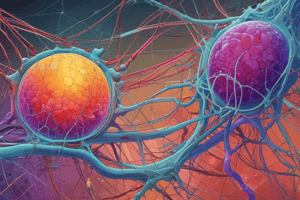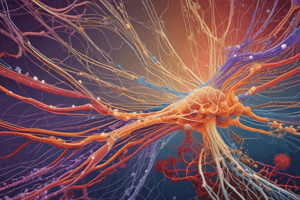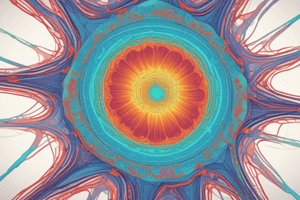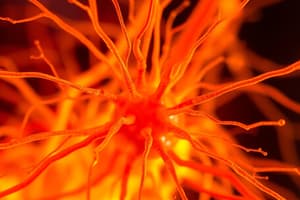Podcast
Questions and Answers
Which of the following statements about the cytoskeleton is true? Choose all that apply.
Which of the following statements about the cytoskeleton is true? Choose all that apply.
- The cytoskeleton is made up of three types of protein filaments. (correct)
- Intermediate filaments are so named because their size is 'intermediate', compared to the other two. (correct)
- Actin is the smallest filament. (correct)
- The cytoskeleton of a cell can change in response to the environment. (correct)
- The cytoskeleton controls the location of organelles in eukaryotic cells. (correct)
Match the images with the types of skeletal filament they represent:
Match the images with the types of skeletal filament they represent:
Image A = Microtubules Image B = Intermediate Filaments Image C = Actin Filaments
Select the correct cytoskeletal filament that corresponds to each statement:
Select the correct cytoskeletal filament that corresponds to each statement:
Monomer that binds ATP = Actin Filaments Includes keratin and neurofilaments = Intermediate Filaments Used in the eukaryotic flagellum = Microtubules Their stability involves a GTP cap = Microtubules Directly involved in muscle contraction = Actin Filaments Supports and strengthens the nuclear envelope = Intermediate Filaments A component of the mitotic spindle = Microtubules Important for formation of the contractile ring during cytokinesis = Actin Filaments
In the polymerization in vitro of actin filaments and microtubules from their subunits, what does the 'lag phase' correspond to?
In the polymerization in vitro of actin filaments and microtubules from their subunits, what does the 'lag phase' correspond to?
For both actin and microtubule polymerization, nucleotide hydrolysis is important for what?
For both actin and microtubule polymerization, nucleotide hydrolysis is important for what?
In a centrosome (i.e. an MTOC), which structures serve as nucleation sites for the formation of microtubules?
In a centrosome (i.e. an MTOC), which structures serve as nucleation sites for the formation of microtubules?
Kinesin and dynein motor proteins each use the energy of _____ to power their movements along ______.
Kinesin and dynein motor proteins each use the energy of _____ to power their movements along ______.
_______ are the motor protein that move directionally along actin filaments.
_______ are the motor protein that move directionally along actin filaments.
If a cell is treated with the drug Vinblastine, which cellular property/process would NOT be affected?
If a cell is treated with the drug Vinblastine, which cellular property/process would NOT be affected?
Flashcards are hidden until you start studying
Study Notes
Cytoskeleton Basics
- Intermediate filaments are termed 'intermediate' due to their size relative to actin filaments and microtubules.
- The cytoskeleton adapts and changes in response to environmental cues.
- It plays a crucial role in determining the positioning of organelles within eukaryotic cells.
- Comprises three main types of protein filaments: microtubules, intermediate filaments, and actin filaments.
- Actin filaments are the smallest among these filament types.
Types of Cytoskeletal Filaments
- Microtubules: Represented by black lines in images; play roles in cellular structure and function.
- Intermediate Filaments: Include proteins like keratin and neurofilaments; provide support and strength.
- Actin Filaments: The thinnest filaments, crucial for muscle contraction.
Filament Characteristics
- Actin filaments bind ATP; essential for their dynamics and function.
- Intermediate filaments are responsible for structural integrity and include keratin.
- Microtubules are involved in flagellar motion and support the mitotic spindle.
- A GTP cap stabilizes microtubules and is vital for their assembly and function.
Polymerization Dynamics
- "Lag phase" in actin and microtubule polymerization refers to the initial phase of nucleation, where monomers aggregate to form stable nuclei before elongation occurs.
- Nucleotide hydrolysis (ATP or GTP) reduces binding strength between filament subunits, facilitating dynamic rearrangements.
Microtubule Organizing Centers
- In centrosomes (microtubule organizing centers), gamma-tubulin rings act as nucleation sites, crucial for microtubule growth.
Motor Proteins
- Kinesin and dynein use ATP hydrolysis for their movement along microtubules, enabling intracellular transport.
- Myosins are the motor proteins that translocate along actin filaments, essential for various cellular processes.
Drug Effects
- Vinblastine disrupts microtubule dynamics but does not impact the reformation of the nuclear envelope, illustrating differential effects of drugs on cellular functions.
Studying That Suits You
Use AI to generate personalized quizzes and flashcards to suit your learning preferences.




